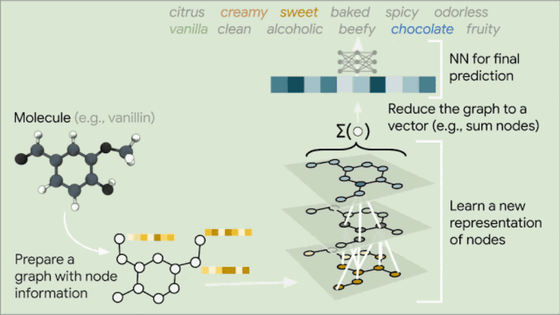Google develops AI to sniff and predict odor from molecular structure

by
Human senses are being digitized by advances in artificial intelligence (AI), such as decoding ancient Greek inscriptions, distinguishing baby crying, and distinguishing liquid taste . Google announced that it has developed an AI that predicts odors by analyzing the structure of the molecules that cause odors.
Machine Learning for Scent: Learning Generalizable Perceptual Representations of Small Molecules
(PDF file) https://arxiv.org/pdf/1910.10685.pdf
Google AI Blog: Learning to Smell: Using Deep Learning to Predict the Olfactory Properties of Molecules
https://ai.googleblog.com/2019/10/learning-to-smell-using-deep-learning.html
Human olfaction is perceived as sensors by about 400 types of olfactory receptors on the mucous membrane in the nostril. Olfactory receptors are activated by binding to specific molecular structures, and olfactory neurons (OSNs) fire. The fired OSN sends a signal to the tissue called the olfactory bulb in the brain, and the olfactory bulb that receives it sends a signal to various parts of the brain to process olfactory information.
Therefore, even if the olfaction itself could not be reproduced, the research team at Google thought that it would be able to sniff the scent even if it could detect the odor molecule that was the source of the scent .
To learn odors with AI, it is important to tag 'types of odor molecules' and 'what kind of odors'. The Google research team created a data set consisting of approximately 5000 different molecules identified by the perfumer, and labeled each molecule with an odor descriptor. For example, a substance called vanillin extracted from vanilla is known to be the source of a sweet odor like vanilla ice, and it is set with odor descriptors such as `` sweet '' `` vanilla '' `` creamy '' `` chocolate '' It has become.
AI uses a graph neural network (GNN) to identify and identify the structure of odor molecules at the atomic level. Specifically, it seems that the structure of the odor molecule is specified by multi-layered analysis of the number and connection of carbon and hydrogen in the molecule. And by training GNN using about two-thirds of the data set, AI can predict the odor of the molecule based on its molecular structure.

However, there are many unexplained parts about odor science. For example, D-limonene, an odor component of citrus, and L-limonene, an odor component of peppermint and spearmint, are

by Wikimedia Commons
Google's research team says that for research that smells with AI, `` Design of new odor molecules that can be produced at low cost '' `` Digitalization of odors '' `` Someone who lost olfaction will someday smell of roses or rotten eggs He said there are many possibilities for the future, such as creating an opportunity to feel scents, and `` I want to attract attention to scent issues from the world of machine learning by finally sharing high-quality and open data sets. '' I commented.
Related Posts:







